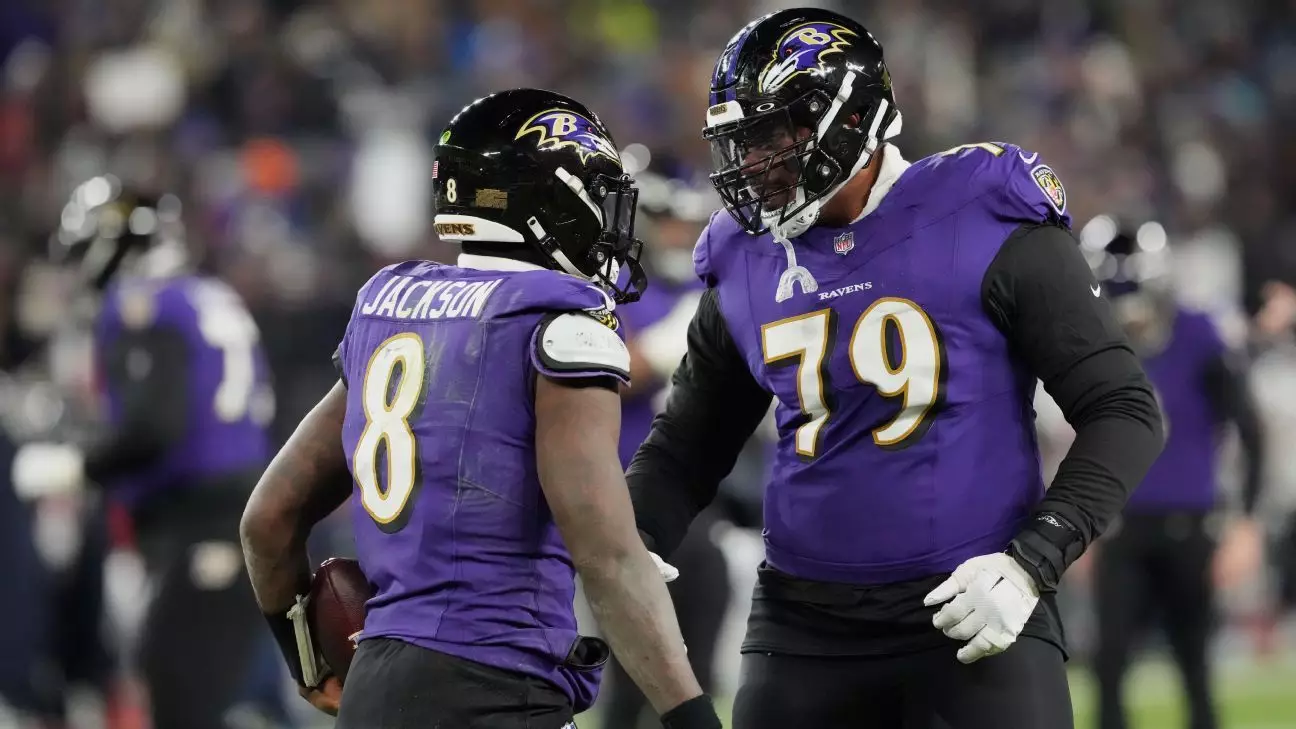After a heart-wrenching 27-25 defeat against the Buffalo Bills in the divisional playoff, the Baltimore Ravens find themselves at a pivotal moment in their franchise’s history. Offensive tackle Ronnie Stanley, visibly impacted by the loss, summed up the emotional toll and uncertainty facing him and the organization. “This one is going to hurt for a while,” he admitted, reflecting on what he termed the toughest loss of his career. This moment encapsulates not just his personal struggle but also the impending decisions that will shape the Ravens’ future, particularly regarding their offensive line.
As the Ravens prepare for the upcoming offseason, they must address one of the most critical decisions in recent memory: whether to retain Stanley, who has been a cornerstone of their offensive front since being drafted as the sixth overall pick nine years ago. With Stanley’s impending free agency, the Ravens need to weigh practical considerations such as salary cap space against the invaluable experience and skill he brings to the field.
Stanley’s 2022 season was a comeback story, having previously faced significant setbacks due to multiple injuries, including a career-altering ankle injury in 2020. His performance last season marked a resurgence. He played every game for the first time and ranked 12th in pass-block win rate among NFL tackles at an impressive 92.5%. This resurgence can’t be understated; it underscores his ability to adapt and lead, qualities the Ravens desperately need as they navigate the complexities of both Stanley’s and their own futures.
However, Stanley’s age—he will soon turn 31—coupled with the fact that he has missed a remarkable 36 games over the past five years, raises legitimate questions about his long-term availability and reliability. The Ravens’ management must balance their desire to retain a proven talent against the realities of an aging athlete’s durability.
Ravens General Manager Eric DeCosta has also hinted at the broader strategy moving forward, stating, “Our goal is to always have the best offensive line that we can have.” Yet, the Ravens are projected to be among the least stocked in salary cap space, complicating their ability to maintain key personnel. As Stanley approaches free agency, it adds another layer of intricacy to the negotiations.
The financial implications of Stanley’s return are significant. Last offseason, he took a drastic 50% pay cut to stay with the team, demonstrating his attachment to Baltimore—calling it “a second home.” However, this raises the question: how much further will both Stanley and the organization be willing to sacrifice for the sake of continuity?
If Stanley opts to leave the Ravens, the team has potential solutions, although none come with the same level of skill and experience. Right tackle Roger Rosengarten, who played 14 games in his rookie season, could shift over to left tackle. Rosengarten’s familiarity with both tackle positions could serve as a valuable asset if the Ravens need to pivot quickly. DeCosta’s optimism about Rosengarten’s growth further highlights the Ravens’ commitment to flexibility and adaptability within their offensive line strategy.
Compounding the situation, starting left guard Patrick Mekari is also a free agent. This dual uncertainty leaves the Ravens in a precarious position. Baltimore has exhibited a willingness to rejuvenate its offensive line by letting go of older players in favor of younger talent. The transition from seasoned veterans like Kevin Zeitler and Morgan Moses to younger players like Rosengarten and Daniel Faalele paid dividends last season, resulting in the Ravens’ first No. 1 offense and a league-best run game.
The Ravens’ management acknowledges the growing pains of transitioning to a younger lineup. DeCosta admits that although there were struggles initially, the improvement and coherence seen as the season progressed prove that the decision to invest in young talent was sound. As the Ravens look back at the previous season’s challenges, they must also prepare for future uncertainties—especially concerning Stanley’s potential departure.
The organization finds itself at a crossroads, where they must blend emotion and pragmatism. The decisions made in the coming months could very well shape the franchise’s trajectory. Through maintaining key players like Stanley or strategically shifting to younger talent, the Ravens are forced to navigate these complex dynamics in search of a cohesive and effective offensive unit.
The off-season decisions surrounding Ronnie Stanley illustrate a microcosm of the larger challenges facing the Baltimore Ravens. Balancing loyalty, salary cap restrictions, and the quest for sustained excellence will ultimately define how the Ravens proceed as they emerge from this tough postseason loss. The stakes couldn’t be higher as they look to solidify their future, both on and off the field.

